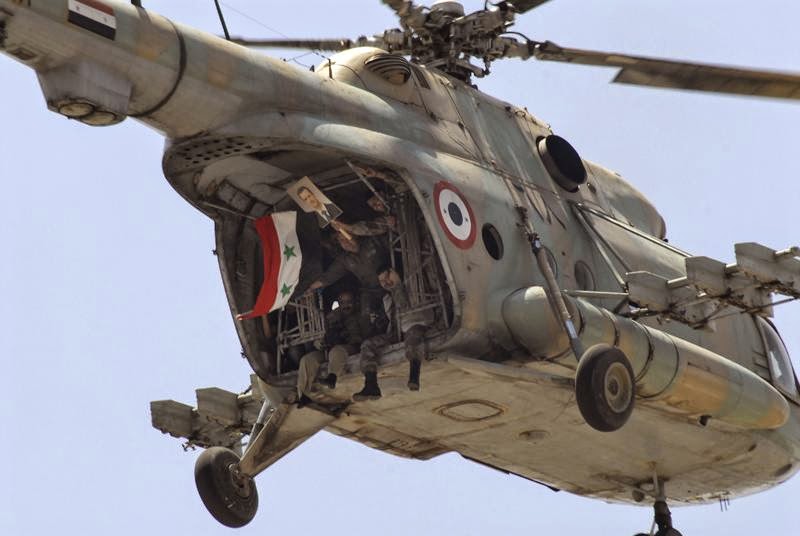
Syria's battered Mi-17s have been on the forefront on the Syrian Arab Air Force's aerial campaign against the rebels for pretty much the entire duration of the now almost four-year long Civil War. Together with the Mi-8s, these versatile platforms perform every task from supplying besieged Syrian Arab Army garrisons, dropping barrel bombs over towns and even flying attack sorties against rebel positions. This while under threat of MANPADS, heavy machine guns, anti-aircraft guns and even your occasional TOW ATGM targeting helicopters while landing.
It now appears several Mi-17s have been upgraded with armour plates and even a forward looking infrared (FLIR) camera, allowing for even greater flexibility while flying attack sorties. The Mi-17 seen in the header, armed with a UPK-23 gun pod, is one of examples to have been upgraded in this fashion. The image, taken at the 20th of May 2013 at Mezze, likely features a Mi-17 from the resident 909 Squadron.
Although one would expect more examples are slated to be upgraded in this way, just a couple of Mi-17s were seen equipped with armour plates and FLIR.
It is unclear if this Mi-17 was upgraded by 'The Factory', the SyAAF's overhaul and maintenance center at Neyrab/Aleppo IAP. 'The Factory' is responsible for maintaining and upgrading most of the SyAAF's inventory of aircraft and helicopters, including its Mi-8s and Mi-17s. If the armour plates and FLIR were installed before the Civil War, this would have taken place at 'The Factory', and their logo would definitely be present on the cockpit of the Mi-17. A puzzle impossible to solve without a clear view of the other side of the cockpit.
To add to the confusion: a large part of the Mi-17 fleet also underwent periodic maintenance at 'The Factory', so the logo could instead refer to just a regular overhaul.
Alternatively, a limited amount of Mi-17s were upgraded early in the Civil War by Russian or Iranian experts based here. The Mezze-based examples are generally in a better condition than the rest of the Mi-17 fleet, so it makes sense they were chosen to be upgraded.
Mezze is also home to much of the Iranian and Russian activity inside Syria. It serves as the main base for UAV operations undertaken by Iran's Revolutionary Guards inside Syria, and the Russian Aircraft Corporation MiG just opened an office blocks away from Mezze's runway.
The armour plates (designed and produced by Russia) aligned around the cockpit were thus likely provided by Russia to the SyAAF in the past years. The same armour plates but on a Serbian operated Mi-17 can be seen here.
The origin of the FLIR remains unknown, but could have been acquired via Russia or Iran, or on the civilian market via several front companies. Its unusual placement to the back of the fuselage clearly distinguishes it of many production variants with FLIR cameras usually mounted to the front.
An additional insightinto the upgrade was provided by the Free Syrian Army when they captured Taftanaz heliport on the 11th of January 2013. One FLIR along with its control console fell in the hands of the FSA here. At least fifteen Mi-8s and Mi-17s were captured at Taftanaz, of which at least one was an upgraded example, which can be seen here. This Mi-17 comes with the logo of 'The Factory'.
The Mi-17 has not been upgraded with new flare and chaff dispensers to counter the threat of MANPADS. This might indicate the SyAAF is still satisfied with the current dispensers already in use on the Mi-17 fleet, and does not deem the rebels' anti-air capabilities to be significant enough to spend valuable resources on. These indigenously designed dispensers were installed on the Mi-17s well before the start of the Civil War, and can be seen on the tail boom of every SyAAF operated Mi-17.
The addition of armour plates and a FLIR camera to the already present flare and chaff dispensers turns the Mi-17 into an even more proficient attack platform, with the means to continue operations at night with largely undiminished capabilities. One could argue their new outfit makes them better suited for a range of combat roles in this conflict than other rotorcraft like the Mi-25.
Special thanks to Luftwaffe A.S.
Recommended Articles
The Syrian Arab Air Force, beware of its wings





